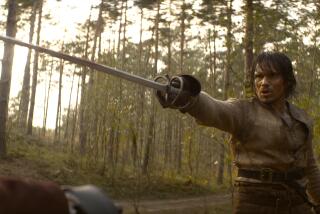American ‘Baby’ Grows Out of Its French ‘Cradle’
- Share via
Travel certainly is broadening, you have to tell yourself as you watch “Three Men and a Baby.”
It is not, you understand, that the American major studio version of Coline Serreau’s French comedy “Three Men and a Cradle” is not a big, colorful, enjoyable entertainment. It is. And, boy, is it big .
The adaptation (scripted by James Orr and Jim Cruickshank, directed by Leonard Nimoy) is a casebook example of Franco- American philosophical differences in film making, which in this case might be summed up respectively as “a little is enough” and “more is more.”
The French “Cradle” (for purposes of shorthand identification) is unapologetically a comedy with farcical overtones, not a social drama with funny moments. A busted drug deal and menacing thugs are on hand as comical elements.
But the heart of the film is a love story--the love of these two and then three bachelor fathers for an irresistible infant. Their early ineptnesses at child care are broadly funny, but the intimacy of Serreau’s watch on the proceedings makes the comedy warmly likable as well. Given the unlikely basic premise, the events somehow achieve at least a psychological credibility.
Hollywood’s “Baby” opens with a large, smoky, raucous, raunchy birthday party that establishes the swinging nature of the pals and their pad. The message is that no expense has been spared to make the goings-on larger than life (with the attached presumption that they will also be funnier than life).
Everything is bigger. The confusion with diapers, already established quite coincidentally as a sub-genre by Diane Keaton in “Baby Boom,” is even more extensive this time, and I’m not sure whether Pampers should pay or sue.
If one infant incontinence is funny, five are not necessarily five times as funny. The underlying notion, which had to be accepted in the French version as well but is even more urgently required here, is that none of these six adult males has ever seen or held a living infant before, never had a younger sibling, niece, nephew or confronted the newborns of proud parental acquaintances. It is international yuppie sterility with a vengeance.
You’d have thought the baby was an alien sprung gurgling from a magic mushroom.
The French males were doubtless familiar to French audiences but less so here, and their lack of star image gave “Cradle” an additional measure of believability (or made it that much easier to accept plot as plot, let’s say).
The casting of Ted Danson, Tom Selleck and Steve Guttenberg here suggested that the French might comparably have used Gerard Depardieu, Alain Delon and Jean-Pierre Leaud. Mlle. Serreau could doubtlessly not afford the casting and it is not clear that she would have wanted to.
But the stars remain in their courses here, and by and large the idea more often than not is to hope that the material can be tailored to fit the principals. Danson, Selleck and Guttenberg are very good; there is no question that they are stars, or why.
And something quite remarkable happens. Despite all the costly trappings, the razzle-dazzle apartment set, the star presences and the prowlings about Manhattan, finally the intimacy and the fathers-and-daughter love story assert themselves.
The inherent warmth that made Serreau’s original so beguiling (and attractive to an American studio) can at last be felt in the new version. It is as if there were a cool corner of quiet amid all the bright tumult. Then again, when has it not been true that a pretty baby can steal any scene ever written? As Nimoy has shown before now, he can handle “Star Trek” logistics but he is also a director of sensitive and likable performances, and it’s the performances at their quietest that win the day for “Baby.”
There is no trouble tracing the influence of madcap romantic Hollywood comedy in French film and only a little more trouble seeing the influence of the realistic French approaches to character and relationships in Hollywood films. It is a beneficial trade.
In this case, it seems likely that all its glossy and whiz-bang elements commend “Three Men and a Baby” to a wide commercial audience. But it is also likely that the trace elements of Serreau’s “Three Men and a Cradle,” its endearing humanity, will give the new film its staying power.
More to Read
Only good movies
Get the Indie Focus newsletter, Mark Olsen's weekly guide to the world of cinema.
You may occasionally receive promotional content from the Los Angeles Times.










